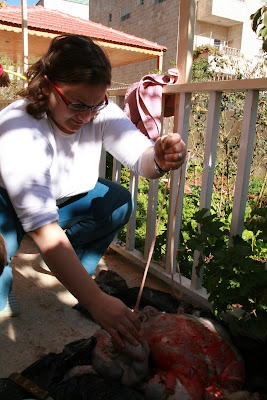
extracting intestines to prepare for dinner
photo by audrey farber
photo by audrey farber
Stomach is prepared by boiling several times to clean it, then cut up and sewn into little pouches stuffed with rice, chickpeas, and vegetables, and then cooked. It smells rancid from beginning to end and tastes as bad.
The intestines are a whole different ball game. Having watched them come flopping out of a dead sheep hanging upside down from his feet, then watched the bile and fecal matter be squeezed out of them--including a priceless moment when they encountered a hole in the intestines and squirted out all over the place--then boiled, boiled, and boiled again, and finally stuffed with the same rice mixture as went into the stomach, cooked, and eaten - it was all a bit too much for me.
I ate it, but I had only as much as required by etiquette and was still nauseous several days later. Now I can't eat lamb without flashbacks to the taste and smell of festering digestive organs.
The two upsides are that, first, I have seen an animal slaughtered and I can still eat meat--something very few carnivores can say and second, the entire experience was a reminder that there are cultures in the world today that still appreciate an animal for what it is and what it provides us, utilize the entirety of its edible parts, and let nothing go to waste.
No comments:
Post a Comment
name:
location:
comment: